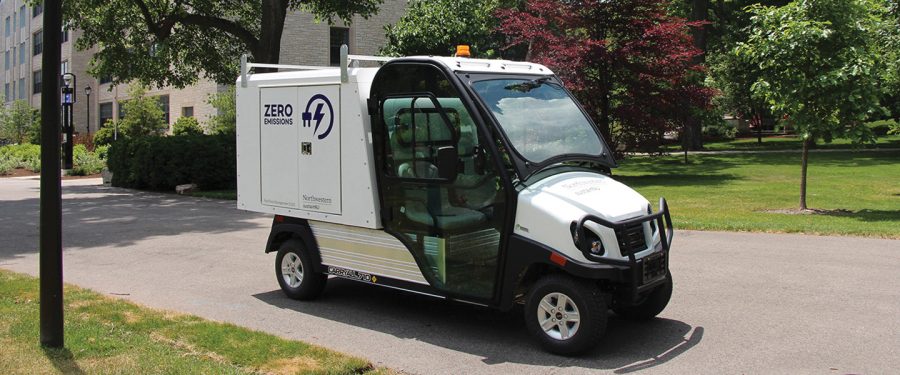Buchaniec: NU’s goal should be zero-carbon, not carbon-neutral
Source: Northwestern University sustainNU
A Northwestern electric vehicle. Northwestern intends to reduce its greenhouse gas emissions by 30 percent from its 2012 base line by 2030 and achieve net zero emissions by 2050.
February 25, 2019
This is the second in a series about sustainability at Northwestern University in light of the 2018 UN Intergovernmental Climate Report. In the report, scientists concluded that in order to prevent 1.5 degrees C of warming, greenhouse gas pollution must be eliminated by 2050 in order to mitigate the major effects of climate change.
In my column last week, I talked about a practice I wanted Northwestern to adopt: The elimination of single-use plastic from out campus. However, this week, the topic I would like to discuss is a goal Northwestern is already aiming to achieve: The reduction of its carbon dioxide and greenhouse gas emissions.
According to its Strategic Sustainability Plan’s Implementation Roadmap, NU intends to reduce its greenhouse gas emissions by 30 percent from its 2012 base line by 2030 and achieve net zero emissions by 2050.
Carbon dioxide emissions are the largest contributor to human-induced warming; yet, according to our Greenhouse Gas Emissions Inventory, Northwestern’s greenhouse gas emissions have only decreased three percent since its 2012 baseline. In five years, we barely made a dent in the one of the greatest threats to mankind. The rate at which we’re addressing this emerging catastrophe is that of a snail, not one of swift and substantial action.
The mission of sustainNU is to “engage students, faculty and staff in reducing — and eventually eliminating — NU’s contribution to climate change,” but “eventually” needs to happen sooner rather than later.
In 2010, American University in Washington D.C. pledged to achieve net zero emissions by 2020, and in 2018 they did just that, two years ahead of schedule. It took just eight years for a school of more than 13,000 students to become the first carbon-neutral university in the United States.
In contrast, we, a school of over 22,000 students, will take over 38 years to achieve that same goal.
Despite the differences in regards to total enrollment and the overall size of each university’s respective campus, the sentiment is the same. We claim to be committed to fostering environmental and ethical stewardship; however, our actions do not reflect that commitment.
Regardless of our financial budget crisis, environmental sustainability needs to be a priority for NU. In 2017, NU joined countless other U.S. universities, cities and businesses vowing “to take forceful action and to ensure that the U.S. remains a global leader in reducing emissions” despite President Trump’s intentions of pulling out of the Paris Agreement.
However, in light of the recent UN Intergovernmental Panel on Climate Change report, “forceful action” needs to happen now. Thirty-eight years is too long and comes too late to make meaningful impact.
NU has an obligation to itself and to its students who hail from all over globe — including areas that are already being heavily affected by climate change — to expedite its timeline to become carbon-neutral, and better yet, move towards eliminating NU’s use of carbon entirely.
It is important to note that the terms carbon neutrality and net-zero do not refer to the complete disbandment of the use of carbon; instead, carbon-neutral and net-zero refer to the balancing of the amount of carbon released with an equivalent amount offset.
For example, a building with solar panels that produce the same amount of energy it uses from the grid is considered “carbon-neutral” or “net-zero.” The building in question still uses energy from the grid, but at the same time, produces an equivalent amount of energy from the solar panels.
Instead of aiming for net-zero/carbon-neutral by 2050, we should endeavor to achieve a “zero-carbon” status, meaning our university would be completely off-the-grid, running entirely on renewable energy.
When we limit our goals to net-zero and carbon-neutral, we fail to completely address the problem — American University and, according to our Strategic Sustainability Plan’s Implementation Roadmap, NU in 2050, will continue to release carbon dioxide into the atmosphere. If we want to fulfill our promise of protecting the environment, we need to go carbon-neutral in the next 10 years and aim to entirely eliminate carbon dioxide emissions as soon as possible. 100 percent renewable energy needs to become our reality, not just a lofty ambition.
Catherine Buchaniec is a Medill first-year. She can be contacted at [email protected]. If you would like to respond publicly to this op-ed, send a Letter to the Editor to [email protected]. The views expressed in this piece do not necessarily reflect the views of all staff members of The Daily Northwestern.


